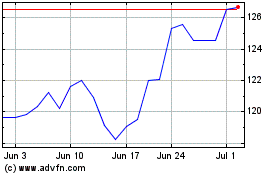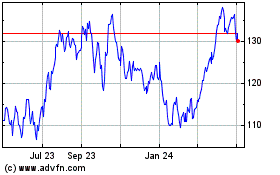By Bradley Olson
HOUSTON -- One of the pioneers of the U.S. shale boom plans to
deliver a surprising message at a major energy conference here this
week: U.S. oil production won't keep growing as fast as the market
seems to think.
Mark Papa, the former chief executive of industry bellwether EOG
Resources Inc., said in an interview he is eager to tell the
assemblage of oil chieftains that a widely held view that shale oil
producers can quickly ramp up production, and sustain those levels
if needed, is wrong.
"The oil market is in a state of misdirection now," said Mr.
Papa, 71 years old, currently head of smaller shale company
Centennial Resource Development Inc., suggesting future supplies
may be more constrained than experts believe. "Someone needs to
speak out."
Mr. Papa is among a group of shale executives set to meet for a
private dinner Monday evening with Mohammad Barkindo, the
secretary-general of the Organization of the Petroleum Exporting
Countries, which has been constricting its oil output along with
Russia to reduce an oversupply of crude that Americans helped
create. Mr. Papa is then scheduled to speak publicly Tuesday at
CERAWeek, the annual energy confab put on by IHS Markit Ltd.
An engineer by trade, Mr. Papa speaks in kindly tones but often
delivers a blunt message. While he stops short of saying the
industry is headed for trouble, his main point is that shale isn't
the "big bad wolf," or all-powerful disrupter of oil and gas
markets, that it has been made out to be. He strongly takes issue
with the notion -- held by market analysts, executives and
investors -- that U.S. production will long swamp global supplies,
perpetuating lower prices.
In a January speech, he told executives and investors that most
of the best drilling locations in North Dakota and South Texas have
already been tapped. He has lately called out rivals for being too
optimistic about their prospects. And he points to recent
operational challenges such as sand shortages that companies have
disclosed in the Permian Basin in West Texas and New Mexico, the
hottest U.S. drilling region, as a harbinger.
Such constraints, coupled with mounting investor demands for
returns, will equate to much slower U.S. oil production growth than
what most forecasts expect, he said.
Some of Mr. Papa's broadsides are laced with sarcasm, including
his skeptical take on the industry's trend of the moment, the push
to use "big data" and automation to modernize oil fields and
drilling.
"Apparently, you can just use your imagination to dream what
might happen with big data in five or 10 years," he said,
smirking.
Privately, some executives chafe at Mr. Papa's critiques, saying
his commentary is self-serving, since Centennial already holds the
rights to prime drilling land in Texas. Started with little more
than Mr. Papa's reputation, the Permian-focused company went public
in 2016 and is now worth about $5 billion. If the market were to
adopt Mr. Papa's view that shale growth will be limited, it could
push up oil prices and benefit his business. Mr. Papa said he is
motivated by a desire to warn the industry, not any potential
personal benefit.
But Mr. Papa hasn't been alone in disputing forecasts for
spectacular growth in U.S. oil production, which surpassed 10
million barrels a day and broke a 47-year-old record in November,
according to the U.S. Energy Information Administration.
Continental Resources Inc. Chief Executive Harold Hamm, another
shale pioneer, also has questioned the forecasts.
More than a dozen U.S. producers either set lower targets for
2018 production than analysts expected or said they would have to
spend more than anticipated to reach previous output goals. Shares
in an index of U.S. oil companies have fallen 8% this year even as
U.S. oil prices have risen 1.4%, while the S&P 500 index has
gained roughly 0.7%, an indication that investors lack confidence
in their ability to capitalize on higher crude prices.
While some geologists and industry gadflies have incorrectly
predicted the demise of shale for years, Mr. Papa's credentials
make his criticism harder for industry optimists to discount.
"He has a reputation for challenging conventional wisdom and
fostering innovation by creating a culture where people could ask
uncomfortable questions," said Les Csorba, who advises energy
company boards as a partner at executive search firm Heidrick &
Struggles International Inc.
Mr. Papa said he developed a healthy skepticism after his
experience at EOG. As he saw more companies perfect the art of
extracting natural gas from shale, he came to worry that the market
would tip into oversupply.
Engineers doubted the drilling techniques would work for oil
extraction, believing larger oil molecules wouldn't flow as easily
through fractured shale as natural gas. But EOG thought otherwise
and announced its intention to pivot to oil.
EOG proved to be correct as gas prices cratered, and producing
oil from shale became more economically viable. Mr. Papa believes
he is right again this time and shrugs off critics.
"Even though 99% of the industry is dead certain about certain
things, 99% of the industry is often wrong," he said. "I have a
minority opinion right now, but within the next year or two, I feel
pretty strongly that it's going to be proven out."
Write to Bradley Olson at Bradley.Olson@wsj.com
(END) Dow Jones Newswires
March 05, 2018 09:01 ET (14:01 GMT)
Copyright (c) 2018 Dow Jones & Company, Inc.
EOG Resources (NYSE:EOG)
Historical Stock Chart
From Aug 2024 to Sep 2024

EOG Resources (NYSE:EOG)
Historical Stock Chart
From Sep 2023 to Sep 2024
